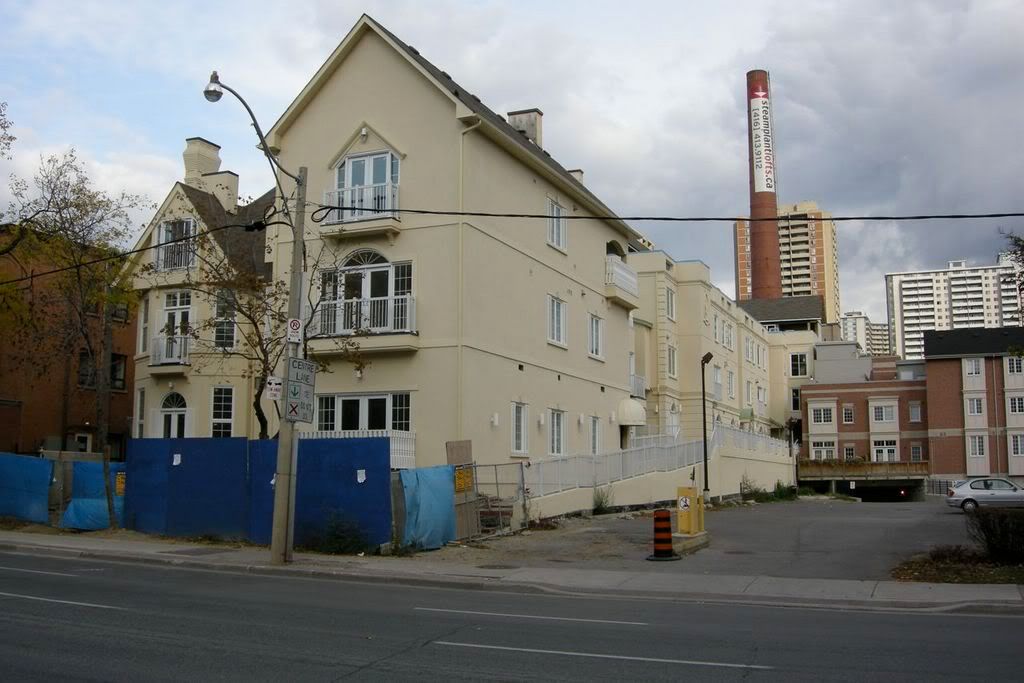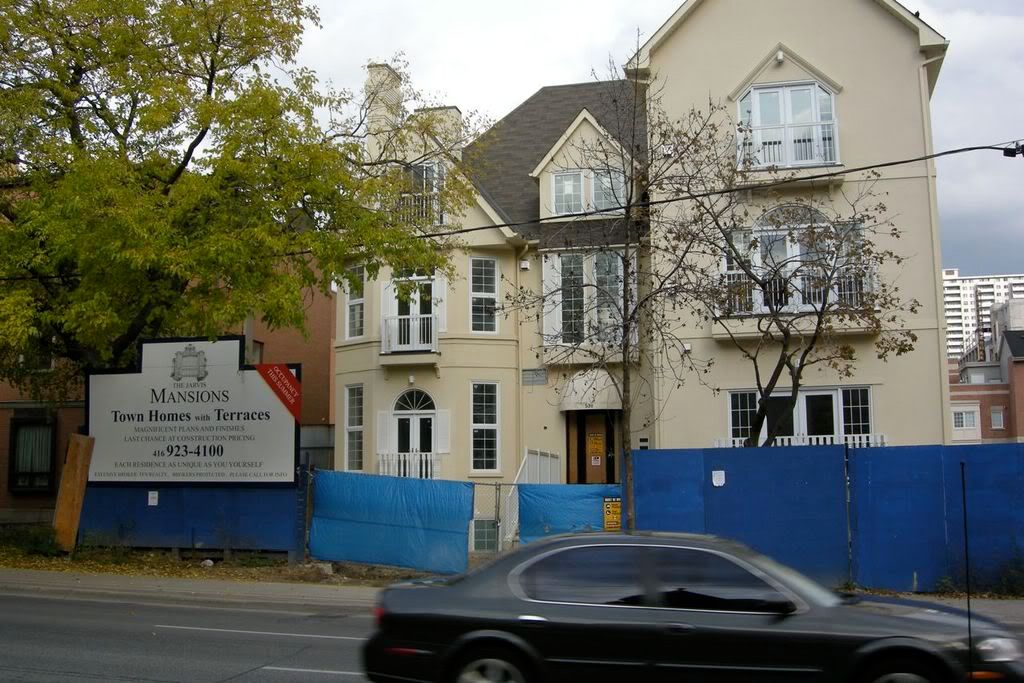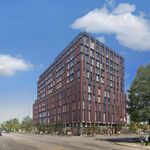For those of you who missed this in the Star, it's pretty heartbreaking for some of the purchasers:
CONDO CONVERSION
Nightmare on Jarvis St.
Purchasers' deposit money tied up four years only to see retrofit project go into receivership days before completion
Oct 06, 2007 04:30 AM
Tracy Hanes
Toronto Star
When Barbara Miodonski was widowed two years ago, she helped deal with her grief by thinking of the joy she would derive from owning a home for the first time in her life.
The 438-square-foot $162,000 unit she was purchasing at Jarvis Mansions – a condo combining new construction and a retrofit of a 19th-century mansion at 539 Jarvis St. – symbolized a fresh start after her husband's death.
"I honestly felt like a tourist in Canada until I could own my own home," says Miodonski, who moved from her native Poland to Toronto 20 years ago. "This project has the feeling of Europe and it very much touched my emotions."
But Miodonski and two dozen other Jarvis Mansions buyers have had their emotions touched in a very different way in the past two weeks. The project by Panterra Mansions Joint Venture Corp. went into receivership with some of their units just days from completion.
Though the buyers will have the opportunity to repurchase their suites, prices will be adjusted to reflect the current market value, not those of four years ago when most of their deals were made.
Though those who choose not to buy will get their initial deposits back with interest (most put down 10 to 15 per cent), they may not recoup thousands of dollars spent on upgrades or any of the equity accrued in Toronto's hot market of recent years.
SF Partners Inc., a bankruptcy trustee, has been appointed as interim receiver after two of the five mortgage holders filed an application to have a receiver take control of the development. Two of the mortgages were at 36 per cent interest. The application was approved on Sept. 24 in Ontario Superior Court.
According to the application, the project came to a standstill because of nine liens against it in July and August, including a $2,043,876.94 claim by the general contractor, Pegah Construction.
In an email to purchasers Caroline and Mike Northfield in late August, Panterra president/architect Sheldon Rosen said the developer was at an impasse with Pegah and construction had "temporarily" stopped.
A phone message left at Panterra offices requesting comment on the receivership was not returned.
An Aug. 7 report from Altus Helyar, a real estate cost consulting firm, said that Pegah had made many change order requests to its original contracted "guaranteed maximum price" of $5,444,000, some of which had been approved, while others had not. The report says due to this "and the ongoing source of funding shortfall on the project," Pegah had not been able to pay their trades in full and work had come to a virtual halt.
Brahm Rosen, senior vice-president of SF Partners Inc. (and no relation to Panterra president Rosen), says construction to complete the project will restart as early as this week and the suites will go back up for sale at current market value soon. He says, "there will be a negotiation" with the original purchasers and the hope is that many of them will still want to buy their units.
The purchasers are considering hiring one lawyer to represent them as a group for negotiations with the receiver. There were 25 sales agreements in all, with 22 made in 2003, with most buyers being either first-time purchasers or empty nesters. Nine units had not sold.
If sales had proceeded under the previous agreements, there would have been an approximate $1.3 million shortfall between the generated revenue and what the project would have cost to complete, according to Altus Helyar.
For the purchasers, the receivership is a bitter end to a frustrating, four-year wait.
The tentative closing date they'd been originally given was Oct. 29, 2004.
However, tentative dates are not firm and can be changed; the "outside" date by which it should have closed was April 29, 2006, according to a sales agreement made four years ago.
Teacher Amy Powell, 39, and her husband Moe Doiron, 41, were excited about becoming first-time homeowners after signing an agreement to purchase a 924-square-foot, two-bedroom garden townhouse for $308,900 on Oct. 4, 2003. Over the next month and a half, Powell and Doiron provided about 10 per cent in deposits and as the project progressed, spent another $7,000 on upgrades.
"What is killing me more than anything is the equity that we have lost," Powell says. "Losing the upgrade money is small potatoes to losing out on the increased value of our original investment."
Deirdre Brennan, a provincial government employee, was living in a townhouse she owned next door when sales at Jarvis Mansions were launched.
She was captivated by the high ceilings and layouts and "thought it would be great for me, being in an old historic mansion." She bought an 840-square-foot, two-bedroom unit for $273,900. Brennan sold her townhouse last March, believing her unit would be ready June 1.
She learned in mid-May it would not be ready. She was allowed to move her furniture into her unit, providing she insured it. She moved in with another resident at her townhouse complex and had to scramble to remove her furniture from Jarvis Mansions three days before the Sept. 24 court hearing.
Brennan is waiting to see what can be negotiated for her to keep her unit.
"It's been quite devastating. I will find out what the best offer is, but I'm not sure I can afford to stay in the Toronto market," she says.
The same goes for Miodonski, whose voice breaks as she discusses her plight.
"It's extremely painful," she says. "I lost my husband and now I feel I lost everything else I had left. I can't afford my unit by myself at current market value. The biggest pain is that someone took my dream away from me. What is the current market value of a lost dream?"
Alan Pinkerton, president of a company that inspects medical gas lines at hospitals, bought a $317,900, 960-square-foot townhouse. He put 10 per cent down and spent about $3,500 in upgrades. Pinkerton, who was living in the neighbourhood, has since moved two or three times as he waited for his townhouse to be built. "I'm no different than a lot of the buyers," he says. "Most of us have sold properties based on move-in dates we were told. We've sold properties prematurely and lost equity. Every week we waited, we lost."
Don Duncan, a consultant, and his wife sold a house in Guelph to buy an 840-square-foot unit for $254,900, plus spent $17,000 for a parking spot and $7,000 on upgrades. He says over the past four years, he has been given 13 move-in dates.
"If I still want to buy it, do I have to buy the upgrades I've already paid for?" he wonders. "I invested time and money to improve this unit, for whose benefit? Our upgrades have enriched its current market value. It's a mess."
Condo law specialist Harry Herskowitz of DelZotto Zorzi LLP, who served on the special committee studying delayed closings for Tarion and is a Tarion board member, says under the Condominium Act Section 81, the upgrade money paid by the purchasers to the developer should have been held in trust; as it was not, the buyers could sue for breach of trust.
As the legal fees could be more than the upgrades cost, Herskowitz says it may not be worth suing individually but it may be worth hiring a lawyer to act for the group. Money paid directly to suppliers likely can't be recouped, he says.
Jean Paul Kyer and his wife Erica put a deposit down on a 1,000-square-foot unit in November 2003.
"It was perfect ... and we were able to redesign it to meet our needs," says Kyer, a consultant for IBM. "We wanted something small but stylish."
In August 2006, they got a call from the developer's staff telling them they should book their move-in date and time for that fall. They sold the loft they had been living in, but as the move-in date came and went, they moved to their cottage at Wasaga Beach and commuted to the city from there — a trip that ate up 3 1/2 hours a day.
Although they originally planned on adding upgrades to their suite, they got into a dispute with the developer because their upgrade money would not be put in trust.
"We were extremely uncomfortable about paying out anything that wasn't in trust," says Kyer. "We wanted to ensure that our money was protected."
Three weeks ago, the couple moved into a house they've purchased in High Park.
Caroline and Mike Northfield, who bought a unit for themselves to live in and a smaller one for investment purposes, have had furniture in storage and have been shuttling between a winter home in Florida and their son's house in Toronto since they sold their house while the wait dragged on.
"Believe me, the stress is awful," Caroline says. "We are pensioners and the money we invested in these units has just been sitting there, not making anything."
Herskowitz agrees that getting deposits back, with nominal interest, is little consolation for these buyers.
"That's not much benefit when condo prices have gone up 20 to 30 per cent in the last years," says Herskowitz. "I feel very, very bad for these purchasers."
He says the outcome would have been no different if the project was a new one covered by Tarion rules, which conversions are not. Herskowitz says Tarion has no plans to start covering conversion projects because the risks are too great. He says, however, that some conversion projects are among the most beautiful and unique condominiums in the city.
Herskowitz says builders "need a certain level of experience before they do conversions ... they are tricky projects. Even very experienced builders can run into unforeseen problems and delays and that eats away the profit margin.
"Builders need to be very well-heeled and very experienced to cover contingencies. Even so, a builder could have had five great experiences with conversions previously, then run into bad luck on the sixth."










